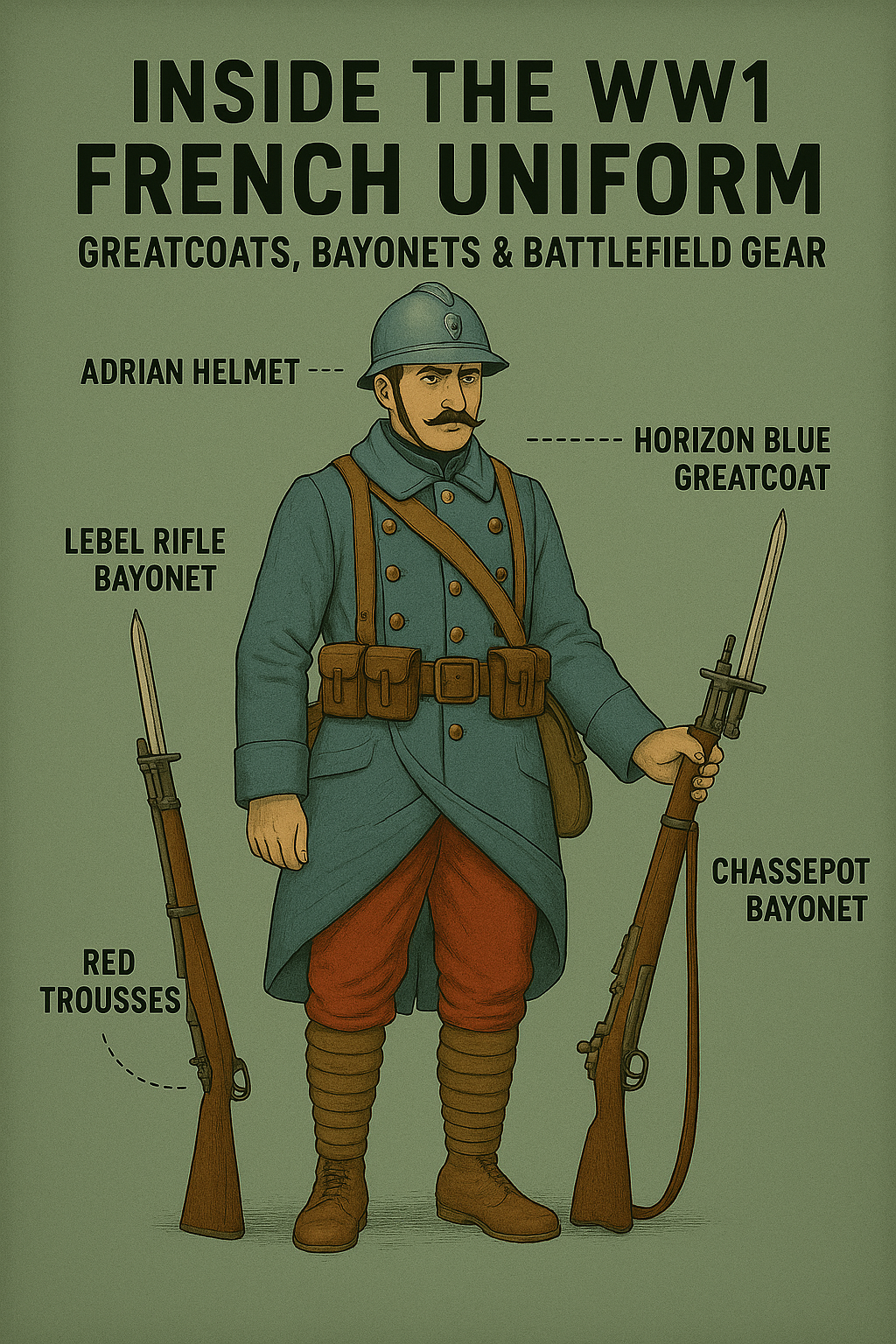
Inside the WW1 French Uniform: Greatcoats, Bayonets & Battlefield Gear
Published on May 12, 2025
WW1 French Uniform Components: A Deep Dive into the Gear of the Great War
The French Army of World War I entered the battlefield with a blend of tradition and innovation. As warfare rapidly modernized, so too did the equipment and uniform of the average French soldier. This article explores the defining elements of the WW1 French uniform, including the well-known Horizon Blue greatcoat and the deadly yet iconic bayonets: the Lebel and Chassepot.
The Transition to Horizon Blue: France’s New Military Identity
At the outbreak of WWI in 1914, French soldiers still wore bold red trousers and dark blue coats — remnants of 19th-century military pride. However, these colors proved to be a tactical disadvantage against the grim backdrop of modern warfare.
By 1915, the French military adopted the “Horizon Blue” uniform. This grayish-blue shade was not only symbolic but practical, blending better with the smoke and soil of the battlefield.
Key Features of the French WW1 Greatcoat:
- Material: Thick wool to withstand harsh winters in the trenches
- Design: Double-breasted front with metal buttons
- Color: Horizon Blue — a shift from flamboyant colors to camouflage
- Functionality: Oversized to layer over tunics; came with large pockets for essentials
- Style: Shoulder epaulettes often indicate rank or branch
The Horizon Blue greatcoat quickly became a defining image of the French infantryman and remains a focal point for collectors and historians today.
WWI French Bayonets: Tools of Close-Combat and Survival
The bayonet was not just a weapon — it was a multi-functional tool. Bayonets like the Lebel and Chassepot were indispensable in hand-to-hand combat, for opening rations, or even trench repairs.
1. Lebel Rifle Bayonet (Model 1886/93 "Rosalie")
Known to French soldiers as “Rosalie,” the bayonet designed for the Lebel Model 1886 rifle is among the most recognized edged weapons of the era.
Specifications:
- Blade Shape: Long, cruciform (four-sided)
- Blade Length: Around 52 cm (20 inches)
- Mounting System: Muzzle ring and socket fit
- Handle: Initially brass, later steel variants introduced
- Function: Designed primarily for thrusting, not slashing
The cruciform blade gave the Lebel bayonet strength and the ability to penetrate thick uniforms and even leather gear. Its minimalist design also made it durable and easy to mass-produce.
2. French Chassepot Bayonet (Model 1866)
Though originally developed in the 1860s, the Chassepot bayonet was still widely used during the early stages of WWI — a testament to its reliability.
Specifications:
- Blade Type: Yataghan-style curved blade
- Blade Length: Approximately 57 cm (22.5 inches)
- Material: Steel blade with brass grips
- Mount Compatibility: Initially for the Chassepot rifle, later adapted to Gras rifles
The curved blade made it ideal for slashing attacks, offering a visual and functional contrast to the Lebel bayonet’s thrusting design. Many Chassepot bayonets were carried into WWI by reservists and colonial troops.
Other Essential Components of the WW1 French Uniform
Helmet (Adrian Model 1915)
France was among the first nations to issue steel helmets. The Adrian helmet provided basic protection against shrapnel and became a visual icon of the French soldier during the war.
Tunic and Trousers
After 1915, French troops wore Horizon Blue tunics and trousers, replacing the outdated and conspicuous red pants. Uniforms were made for rugged conditions with reinforced knees and double-layered elbows.
Leather Gear and Webbing
Each soldier carried:
- Ammunition pouches
- Bread bag or musette
- Bayonet frog
- Belt and suspender system
- Canteen and entrenching tool
These pieces helped soldiers carry rations, tools, and personal effects through long stretches in muddy, chaotic trenches.
Why Uniform Components Mattered in Trench Warfare
Uniforms weren’t just about identification or appearance. In the brutal trench environments of WWI:
- Durability meant survival in harsh weather.
- Camouflage reduced visibility to enemy snipers.
- Storage and utility allowed soldiers to carry more with less weight.
- Weapon compatibility (like bayonet mounts) ensured every tool had multiple uses.
A French soldier’s survival often depended as much on his coat and bayonet as his rifle or training.
Conclusion: The Legacy of WW1 French Military Uniforms
The WW1 French uniform was not just a product of necessity — it was a powerful symbol of adaptation in a time of unprecedented change. From the dignified yet practical Horizon Blue greatcoat to the brutally efficient Lebel and Chassepot bayonets, each component served a purpose in the survival and identity of the French soldier.
